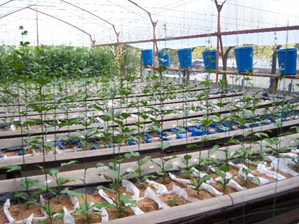Promissory Passiflora L. species (Passifloraceae) for tolerance to water-salt stress

Abstract
The aim of this study was to determine tolerance to water and salt stress in four cultivated Passiflora L. species. Eleven accessions of four Passiflora species of commercial interest from different plantations were evaluated. The experiment design used sub-split plots, where the plot was the percentage of water saturation in relation to the requirements of the crop (33 and 100%). The subplot was established with the saturation levels of salt (sodium chloride reactive level - 99.9% purity) (EC: 1.5 and 5.5 dS m-1) with the 11 accessions in a completely randomized array with five replications, where the experiment unit was one plant. The results showed that accessions m11, m13 (P. edulis f. flavicarpa) and m15 (P. tarminiana) were tolerant to salinity and drought; accessions m2 (P. edulis f. edulis), m12 and m14 (P. edulis f. flavicarpa) were moderately tolerant. These observations provided a basis for future studies on drought tolerance in Passiflora, which must be followed up with field evaluations.
Keywords
Passiflora spp., Abiotic stress, Dry weight, Genetic resources, Stress physiology
References
Agronet. 2019. Estadísticas agropecuarias. In: Ministerio de Agricultura y Desarrollo Rural de Colombia, https://www.agronet.gov.co/estadistica/Paginas/home.aspx?cod=1; consulted: August, 2019.
Cavalcante, L.F. (ed.). 2012. O maracujazeiro amarelo e a salinidade da agua. Sal da Terra, João Pessoa, Brazil.
Fageria, N.K., W. Soares, and H.R. Gheyi. 2010. Melhoramento genético vegetal e seleção de cultivares tolerantes a salinidade, pp. 212-225. In: Gheyi, H.R., N. Diasand, and C.F. Lacerda (eds.) Manejo da salinidade na agricultura: Estudos básicos e aplicados. Instituto Nacional de Ciência e Tecnologia em Salinidade “INCTSal”, Fortaleza, Brazil.
Fan, J., J. Meng, Y. Ashkenazy, S. Havlin, and H.J. Schellnhuber. 2017. Network analysis reveals strongly localized impacts of El Niño. Proc. Natl. Acad. Sci. U.S.A 114, 7543-7548. Doi: 10.1073/pnas.1701214114
FAO. 2020. Versión resumida de El estado mundial de la agricultura y la alimentación. Superar los desafios relacionados con el agua en la agricultura. Roma. Doi: 10.4060/cb1441es
Gomes, M.T.G., A.C. Luz, M.G. Santos, M. Batitucci, D.M. Silva, and A.R. Falquetoa. 2012. Drought tolerance of passion fruit plants assessed by the OJIP chlorophyll a fluorescence transient. Sci. Hortic. 142, 49-56. Doi: 10.1016/j.scienta.2012.04.026
Hurtado-Salazar, A., D.F.P. da Silva, N. Ceballos-Aguirre, J.A. Ocampo, and C.H. Bruckner. 2017. Proline and ions accumulation in four Passiflora species under water-saline stress. Comun. Sci. 8(4), 570-580. Doi: 10.14295/cs.v8i4.2323
Hurtado-Salazar, A., D.F.P. da Silva, N. Ceballos-Aguirre, J.A. Ocampo, and C.H. Bruckner. 2018. Salinity tolerance of Passiflora tarminiana Coppens & Barney. Rev. Colomb. Cienc. Hortic. 12(1), 11-19. Doi: 10.17584/rcch.2018v12i1.7335
Jehová, L.J., Z. Oberdan, R.M. Santos, and C.G. Faustini. 2013. Effects that nutritional and saline gradients have on the growth of Passiflora mucronata Lam. and Canavalia rosea (Sw.) DC. found in the restinga of Brazil. Acta Bot. Bras. 27(2), 318-326. Doi: 10.1590/S0102-33062013000200008
Niu, F., D. Zhang, Z. Li, M. Van Iersel, and P. Alemb. 2015. Morphological response of eucalypts seedlings to phosphorus supply through hydroponic system. Sci. Hortic. 194, 295-303. Doi: 10.1016/j.scienta.2015.08.029
Ocampo, J., R. Urrea, K. Wyckhuys, and M. Salazar. 2013. Exploración de la variabilidad genética del maracuyá (Passiflora edulis f. flavicarpa Degener) como base para un programa de fitomejoramiento en Colombia. Acta Agron. 62(4), 352-360.
Ocampo, J., J.C. Arias, and R. Urrea. 2016. Interspecific hybridization between cultivated and wild species of genus Passiflora L. Euphytica 209(2), 395-408. Doi: 10.1007/s10681-016-1647-9
Rodríguez, N.C., L.M. Melgarejo, and M.W. Blair. 2019. Purple passion fruit, Passiflora edulis Sims f. edulis, variability for photosynthetic and physiological adaptation in contrasting environments. Agronomy 9(5), 231. Doi: 10.3390/agronomy9050231
Silveira, J.A., S. Silva, and R.A. Viegas. 2010. Mecanismos biomoleculares envolvidos com a resistência ao estresse salino em plantas. pp. 205-218. In: Gheyi, H.R., N. Diasand, and C.F. Lacerda (eds.). Manejo da salinidade na agricultura: estudos básicos e aplicados. Instituto Nacional de Ciência e Tecnologia em Salinidade “INCTSal”, Fortaleza, Brazil.
Statistical Analysis System. 2013. SAS User ́s guide v 9.4 (CD-ROM). SAS Institute, Cary, NC.
Yertayeva, Z., R. Kizilkaya, S. Kaldybayev, N. Seitkali, N. Abdraimova, and A. Zhamangarayeva. 2019. Changes in biological soil quality indicators under saline soil condition after amelioration with alfalfa (Medicago sativa L.) cultivation in meadow Solonchak. Eurasian J. Soil Sci. 8(3), 189-195. Doi: 10.18393/ejss.552563
